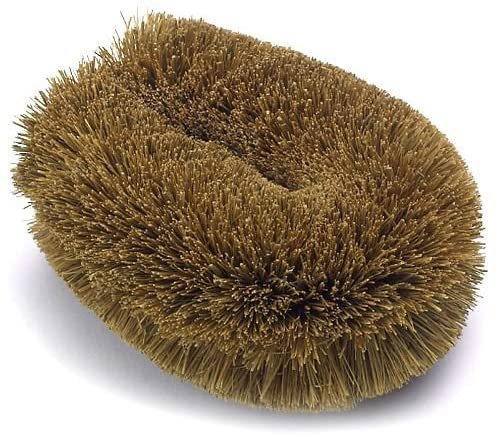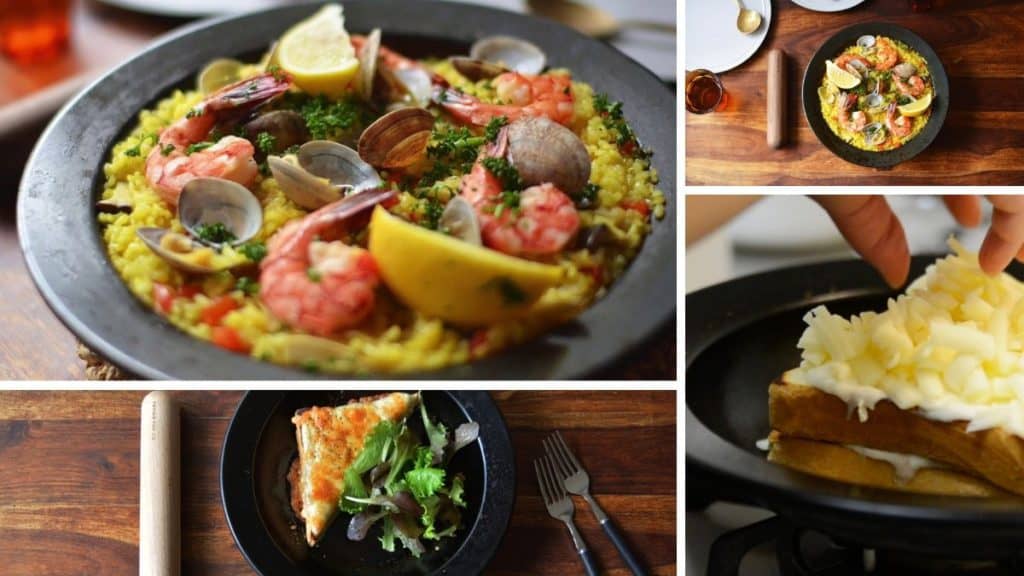While nonstick pans are renowned for their practicality, over time, food and grime inevitably stick to them. We recommend cast iron frying pans as an environmentally-friendly and long-lasting alternative. They are 100% recyclable and the envy of all those who adore cooking. However, selecting the perfect cast iron frying pan can be difficult. So, we asked Seiichiro Fujita from the 70-year-old metal workshop "Fujita Kinzoku" for the best ways to choose and maintain a cast iron pan. We’ll also introduce a few cooking tips along with some recommended dishes to make with a cast iron pan!
Supervising Editor: Seiichiro Fujita from Fujita Kinzoku (Fujita Metal)

Seiichiro Fujita is the representative director of Fujita Kinzoku, a metal workshop located in the city of Yao in Osaka Prefecture that was established 70 years ago. All their metalworking processes are done in-factory, including the production of metal molds used to shape the frying pans, the stamping of prototype frying pans, metal spinning, product inspection, and more. Fujita Kinzoku are particularly renowned for their “hard tempering” processing (read more below), which allows their frying pans to be immediately used after arriving. They are internationally renowned, with an award-studded history including the Osaka Manufacturing Excellence Company Award and OMOTENASHI SELECTION 2017, along with exhibitions at the French Maison&Objet and German Ambiente.
Website: http://www.fujita-kinzoku.jp/ (Japanese)
Website: http://www.fujita-kinzoku.jp/english/ (English)
3 Things to Know Before Buying a Cast Iron Pan

The most important elements to consider when searching for a cast iron frying pan are:
1. Thickness
2. Processing method
3. Purpose of use
Definitely take these into account during your cast iron pan shopping!
1. Thickness Is Extremely Important

In this instance, "thickness” refers to the thickness of the iron used to make the pan. Generally, this will be around 1 mm - 2 mm.
Thickness is particularly important as it dictates the heat capacity properties of the pan. Pans with higher heat capacity will be able to properly transfer heat into the ingredients and cook them better. Cast iron frying pans with thick metal will have better heat capacity, preventing the temperature from dropping when ingredients are placed in them. The effect of this is particularly notable with foods like steak.
However, be aware that the thicker the metal, the heavier the pan becomes, making it more difficult to use. A thickness of up to roughly 1.6 mm will generally allow most people to easily hold and use the pan with one hand. Going up to 2 mm will make it rather heavy, so for everyday home use, a thickness between 1.4 mm-1.6 mm is best.
When selecting a cast iron frying pan, always remember to consider the balance between heat retention and ease-of-use before purchasing!
2. Pay Attention to How the Pan Surface Is Treated

There are three main ways cast iron pans are treated:
①Clear Coating
Clear coating is applied to the surface of many cast iron frying pans to prevent rust. *Requires seasoning (see below)
②Hard Tempering
The body of the pan is fired at 700°C before being soaked in oil, making it highly resistant to rust. This processing method is unique to Fujita Kinzoku.
③Nitriding
The pan is placed within high-temperature nitrogen gas and tempered. *Needs to be seasoned before use (see below).
*Before being used, many cast iron frying pans need to be “seasoned.” This involves heating the pan and coating it in oil afterwards. This prevents food from sticking and curbs rust. Please note that electric stoves will shut off if the temperature becomes too high, sometimes making it impossible to season cast iron pans.
With hard tempering, the pan is heated until it glows red and then soaked in a thin layer of olive oil. This means that the frying pan has already been seasoned by Fujita Kinzoku and can be used as soon as it’s purchased.
3. Consider What You'll Use the Pan For

Cast iron pans come in all sorts of shapes and sizes, which means they have different characteristics. Therefore, it's important to select one based on what you plan to use it for and your preferences.
●If you prioritize heat capacity:
Select a pan made with thick metal.
●If you want a relatively light pan:
Opt for a pan made with thin metal or one with thin sides manufactured via metal spinning.*
●If you want a compact, easy-to-store pan:
Get a cast iron pan with a removable handle.
●If you want a stylish pan:
Search for a skillet-like cast iron pan that has been designed with extra attention placed on appearance.
*Metal spinning uses a rod-shaped tool along with a lathe-like machine. The metal is fitted into the machine and as it spins, it is pushed up against the rod and shaped.
3 Tricks to Make Your Cooking Taste Better With a Cast Iron Frying Pan

1. Don’t Be Afraid to Heat It Up!

Thoroughly creating residual heat is essential to cook effectively with a cast iron pan. If the residual heat is lacking, the pan will be cooled when ingredients are added to it, making them stick to the surface. However, it’s definitely not good to heat it until it smokes, so keep an eye on it and teach yourself how to ascertain the correct temperature.
Furthermore, we strongly recommend using a gas stove over electric. Unlike gas, which evenly heats the entire pan, IH projects heat in a doughnut shape, preventing the center of the pan from being properly heated and causing food to stick.
2. Use a Little More Oil Than Usual
We recommend using slightly more oil than indicated in a recipe book or when cooking with a nonstick pan. A lack of oil will make food stick, especially when you first start using your cast iron pan. However, using too much oil may conversely cause it to spit, so use your best judgement along with trial and error to determine the correct amount.
3. Slowly Cook Food on Low Heat

One guaranteed way to improve the taste of your food is by slowly and thoroughly cooking on low heat, like in the image above. This rule is true for almost all kinds of food, including bread, meat, vegetables, pasta, paella, and more. While it's tempting to view the image below with the large flame as a better way to cook, it actually has the reverse effect! Along with burning the outside, it will prevent heat from properly reaching the core of the ingredients and stop the flavors from being drawn out.

Of course, cast iron pans themselves are highly resistant to flame, so it’s fine to add lots of heat like the above to remove moisture or to season the surface.
However, when cooking food, definitely opt for a lower flame to get that crispy, grilled appearance while drawing out and locking in the flavor!
How to Clean and Care For Cast Iron Pans

Be Careful of Detergent and Water!
After using your cast iron pan, wash it with water and a scrubbing brush or whisk*. If you use detergent, you’ll end up removing the seasoning. If you do end up using detergent on your cast iron frying pan, you’ll need to season it again.
Many dishwashers use detergents with powerful cleaning agents, so it’s best to avoid them completely. After washing with water, don’t forget to reheat it to remove all moisture from the surface.
*Scrubbing brushes are brush-like tools generally made from a bundle of plant fibers (the product in the image above is a “sasara” whisk, which are often made from bundles of bamboo or fine wood). Even outside Japan, these can be found and purchased easily. Alongside frying pans, they can also come in handy when washing vegetables, particularly root vegetables.
KAMENOKO TAWASHI VEGETABLE SCRUB BRUSH × 3 Packs (Japan Import)

Salt and Acid Do Not Mix With Cast Iron Pans
Leaving salty or acidic ingredients sitting in your cast iron pan can quickly lead to rust. Either move the contents to another plate or immediately eat directly from the frying pan.
What If You Don’t Use Your Cast Iron Pan For a While?

Storing away your cast iron pan is totally fine as long as you coat the entire surface in cooking oil as per the image above.
What If Your Cast Iron Pan Gets Rust or Burnt Food Stuck on It?
For Burnt Food, Use Hot Water and a Metal Scrubber
If you’ve accidentally burnt something in your cast iron pan, add water and boil it to make the burnt food soft like in the video above. If it won’t come off through boiling water alone, it’s okay to scrub it with a metal scrubbing brush.
For Rust - Scrape It Off With Sandpaper
For rust that won’t come off with a metal brush, try using sandpaper to scrape it off instead. Cast iron pans are extremely durable, so you can use sandpaper as long as there aren’t any holes.
The JIU Series: Perfect For Outdoor Cooking!

What Is the JIU Series Cast Iron Frying Pan?

This cast iron pan features a removable handle and was designed by the studio TENT and manufactured by Fujita Kinzoku. It has received universal praise for its stylish and easy-to-use plate-like design and sliding wooden handle which can be seamlessly attached and removed with one hand. With a 1.6 mm thickness, it’s ideal for slowly cooking meat and vegetables on low heat.
It is currently available for purchase in the BECOS Store in small, medium, and large sizes along with the choice of a beech or walnut wood handle, with 6 different combinations in total.
A Marvelous Creation Born Through Immense Struggle

The JIU series was devised under the theme of “cooking and eating with the same tool.” With a handle that can be easily detached and reattached through a one-handed sliding mechanism, it has garnered attention and received rave reviews for its fantastic user-friendliness and functionality. However, the creation of this handle came with immense trouble. While the iron parts took just 6 months to design, the handle hogged a whopping 1.6 years! TENT and Fujita Kinzoku often felt like giving up, but their tenacity eventually brought to life the handle they had been dreaming of!
Frying Pans With Removable Handle
JIU Series

Mouthwatering Dishes Brought to Life With the JIU Series

If you’re getting a cast iron pan, one of the first things you should test it out with is a juicy steak!

The JIU series' size and shape also makes them ideal for dishes like paella, which can be eaten straight off the pan!

We also recommend using the pans to toast bread. After adding butter and cooking it on the pan, the remarkable heat capacity of the cast iron will make the outside perfectly crisp and the inside fluffy and soft!
A Cast Iron Pan Like No Other
With a compact design and stylish appearance, the JIU Series are truly frying pans like no other! Plus, they come pre-seasoned! If you wish to add flair to your food, make the jump to cast iron pans and revolutionize your cooking experience!
Related articles:
▶ How to Choose a Japanese Knife That Will Last a Lifetime
▶ 7 Ceramic Cups That Will Make Your Beer Even Better!
▶ Daruma Dolls: Which Eye to Paint First? How to Properly Dispose of Them Abroad?
If you want to give feedback on any of our articles, you have an idea that you'd really like to see come to life, or you just have a question on Japan, hit us up on our Facebook, Twitter, or Instagram!
*These products may not be able to be shipped to certain countries. Please see the retailer's website for more information.
The information in this article is accurate at the time of publication.
